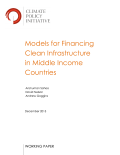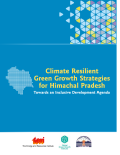The present policy brief draws from an upcoming report by the Economic Commission for Africa (ECA), informed by a survey of nine selected projects in the Lake Victoria Basin complemented with literature, which has established that applying inclusive green economy-related principles and approaches enhances the outcomes of water resource management objectives. This policy brief provides a synthesis of the findings and recommends, among other things, the development and implementation of an inclusive green economy strategy or framework for water resource management in the Basin under the Lake Victoria Basin Commission.
The French version of the policy brief is available here.


Physical infrastructure, such as energy, transportation, telecommunications, water, and sanitation systems, can contribute to the sustained growth of a national economy. The global economy needs as much as $93 trillion of infrastructure investment through 2030, yet many analysts suggest that global investment is lagging behind the required rate.
This paper looks at the challenges faced by rapidly growing middle income countries in financing their infrastructure, and it focuses on the two seemingly very different models employed by the governments of Brazil and India to overcome those challenges. The paper assesses both the potential benefits and drawbacks of each model and how those potential benefits translate into practice once the particular national circumstances of each country come into play.

Himachal Pradesh is a mountain state in India which benefits from a wealth of natural resources but is also ecologically fragile, being situated in the Himalayan region. With climate change, socio-economic and ecological vulnerability has increased and risk-based approaches have become even more relevant. Green growth and sustainable development need to take into account the impacts of climate variability to strengthen policy interventions.
This report carries out an analysis aimed to build knowledge in this area. It uses a mix of analytical tools including a climate model, soil and water assessment, and energy analysis. The report finds that the overall climatic warming projected for the state of Himachal Pradesh in the near future increase by 1.3–1.9°C for 2021–50 relative to 1971–2000. Through a state-specific energy model and onground case studies, the report identifies important issues and pressure points, relevant for the energy and environment sectors.
